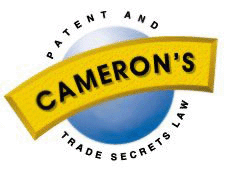
Case Comment
Shell Oil Company v.
The Commissioner of Patents
citation(s): [1982] S.C.R. 536.
 Case Comment |
Shell Oil Company v.The Commissioner of Patents
citation(s): [1982] S.C.R. 536. |
copyright 1997 Donald M. Cameron, Aird & Berlis
Shell applied for a patent on some chemical compositions which were chemical compounds mixed with an adjuvant (a "thinner" or carrier).
The "invention" was the discovery of the usefulness of the compounds as plant growth regulators, some of which were old and some of which were new.
"The central issue in this case, it seems to me, is not directly covered by any of these authorities although all are helpful in providing the jurisprudential context into which the issue must fit. The appellant has discovered that compounds having a specific chemical structure have useful properties as plant growth regulators. Although some of these compounds were already known, their usefulness for this particular purpose was not known. This new use for these old compounds is therefore the appellant's "invention" with respect to these old compounds. In order to use them for this purpose, it has mixed them with the appropriate adjuvants for their application to plants. Other compounds having the same chemical structure have been produced by the appellant and are therefore new compounds. They are per se an "invention" of the appellant and the respondent acknowledges that they are patentable. The appellant, however, has withdrawn its claim for patent on those and seeks instead a patent on compositions formed by mixing them with appropriate adjuvants.
The following questions seem to me to arise on these facts:
The old compounds:
1) Is a new use for an old compound patentable under the Act?
2) If so, how is it patented?
The new compounds:
1) Does the principle in the Farbwerke Hoechst line of cases apply to an invention not falling within s. 41 of the Act?
2) If not, does an applicant have an election whether to claim for the new compounds or for the compositions containing them?
3) Does a claim for the compositions violate s. 36 of the Act?
The old compounds:
No authority was presented to the Court dealing with a claim based on the discovery of a new use for an old compound and my research has disclosed none. I turn therefore to the definition of "invention" in s.2 of the Act which reads:
"invention" means any new and useful art, process, machine, manufacture or composition of matter, or any new and useful improvement in any art, process, machine, manufacture or composition of matter;
If we accept the submission of counsel for the Commissioner that a claim for the compositions containing the old compounds cannot be dignified into a process claim because there is admittedly no novelty in combining the compounds with the adjuvants, then Ciba is distinguishable. It is not the process of mixing the old compounds with the known adjuvants which is put forward as novel. It is the idea of applying the old compounds to the new use as plant growth regulators; the character of the adjuvants follows inevitably once their usefulness for that purpose has been discovered. What then is the "invention" under s. 2? I believe it is the application of this new knowledge to effect a desired result which has an undisputed commercial value and that it falls within the words "any new and useful art". I think the word "art" in the context of the definition must be given its general connotation of "learning" or "knowledge" as commonly used in expressions such as "the state of the art" or "the prior art". The appellant's discovery in this case has added to the cumulative wisdom on the subject of these compounds by a recognition of their hitherto unrecognized properties and it has established the method whereby these properties may be realized through practical application. In my view, this constitutes a "new and useful art" and the compositions are the practical embodiment of the new knowledge.
If I am right that the discovery of a new use for these compounds which is capable of practical application is an "invention" within the meaning of the definition, I can find nothing in the statute which would preclude a claim for these compositions. Section 36 does not seem to present a barrier because the inventive ingenuity here lies in the new use for the old compounds and not in the compounds themselves. Having discovered the use, the appellant has then combined the compounds with the appropriate carriers for their application to plants. It is not, in my view, necessary in the case of the discovery of a new use for an old compound that the combination of the compound with the adjuvant be itself novel in any sense other than that it is required in order to give effect to this particular use of the compound. This is not a case where the inventive ingenuity is alleged to lie in the combination: the combination is simply the means of realizing on the newly discovered potential of the compounds. This is a case where the inventive ingenuity is in the discovery of the new use and no further inventive step is required in the application of the compounds to that use, i.e. in the preparation of the appropriate compositions."
Return to:
Cameron's IT Law: Home Page; Index
Cameron's Canadian Patent & Trade Secrets Law: Home Page; Index